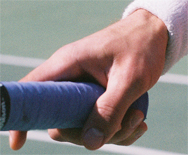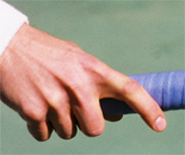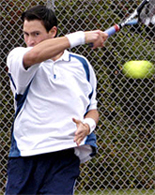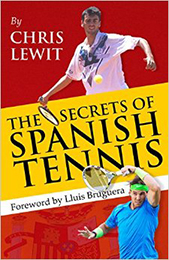Keys to the Kick
Chris Lewit
Is there anything harder in tennis than learning a great kick serve? The topspin serve is, in my opinion, the most difficult shot in the game and arguably the hardest to teach. Students often struggle for years before figuring out the proper mechanics--sometimes only by luck or trial and error. Other players give up and relegate themselves to hitting only slice and flat serves.
A few talented players will pick this serve up easily, but for mere mortals--the less gifted 99 percent rest of us--learning the topspin serve comes as a tremendous challenge. I spent years in the juniors hitting thousands of balls before finally mastering this serve in my twenties. That was not until after college when I was competing on the ITF pro futures tour.
For me, it happened because I found a new coach and former elite tour player who shared with me the secrets of mastering the kick. I almost want to cry when I think of all the hours I spent hitting buckets and buckets of balls. My coaches in the juniors were great guys, but they didn't provide me with the technical framework and the check points I needed to understand and master the shot. This is the same problem most players face. They are never exposed to right technical framework or training system.
My goal in this first article is to present the technical elements and check points that are critical to learning and teaching the kick. As you will see, there are many components to master, and this is what makes the serve so challenging. In a second article, I will share an additional series of unique drills that I use every day with my students to develop the kick.
Using this approach, I have taught hundreds of junior players to hit great kick serves, from as young as 6 year old beginners to 16 year old top national players. I have also taught the same serve to serious adult players at many levels.
The Three Kicks
For the sake of clarity in this article, I will use the terms "topspin" and "kick" interchangeably. But in reality there are three variations of the kick serve.
These three variations are what I call True Topspin, Slice Topspin, and Twist. The differences are in the path of the ball through the air, the path of the ball after the bounce, and most importantly to understand, how the racket moves to the contact to produce these differences. Let me define what I mean by each of these three serves.
What I call True Topspin bounces high and straight ahead. This serve is the most basic kick serve and most players will use it for the second serve a large percentage of the time, especially on hard courts. When well executed this serve is heavy and difficult to deal with because it can bounce well above the returner's preferred contact height.
What I call SliceTopspin bounces high but (from the server's perspective) also has a right-to-left movement after the bounce. Players will use this serve less frequently than the True Topspin, typically when hitting second serves down the T in the ad court, or into the body or out wide in the deuce court. The advantage here compared to the True Topspin, is that the ball fades or curves away from the returner (or in the case of a body serve, jams the returner). This serve is a must to hit effective second serves against left handers.
The third topspin variation is the Twist. What I call Twist bounces high but actually moves from the server's left to his right. Typically it is hit to the returner's backhand, especially in the ad court, where it kicks high away from the player after the bounce.
This serve is used to pull the returner out of position, force him to take additional steps to the ball, and play a contact point at shoulder level or even higher. It is used most often on clay, but can also be extremely effective on hard courts--especially gritty or high-rebound hard courts--when hit with the right combination of speed and spin.
So let's look at the checkpoints for all three kick serves. We'll look at the elements they have in common and also the adjustments players must make to hit each of the three variations.
The Components
There are multiple technical components in the kick serve, and this complexity is one thing that makes the serve difficult. Even though there is a lot of information, it is important to understand each of the components clearly, and then how to put them together in the complete motion.
These components are:
No wonder players and coaches struggle with this motion. If even one technical element is missing, the serve may not be effective. Let's go over the components from start to finish starting with the grip.


Grip
The grip is critical to learning an effective topspin serve. Most players who come to me do not demonstrate a strong enough grip to effectively hit heavy spin. I call this grip a Strong Continental. The problem is that most players try to hit the serve with a milder version of the continental, or even with a grip rotated toward an eastern forehand.
The frustrating thing about defining the right grip is that coaches--and especially coaches from different countries--use different terminology and also tend to have different opinions about the position of the index knuckle.
I remember first working on my kick with my tour coach, a former top 100 ATP player and national coach from Israel. He showed me the grip that I now teach. This grip is definitely more extreme than the typical "continental" as defined by most coaches in the US.
Whatever you want to call it, I believe in this "strong continental," with the index knuckle very near bevel 1 (top bevel). This grip promotes heavy spin without slowing down the ball too much, as a more extreme backhand serve grip can do. I also believe players can hit the first serve with this grip, rather than making a dramatic grip change between first and second serves, which can hurt disguise.
Of course, some players are extremely talented with their wrists and hands, and they can get away with a less extreme grip. But I believe even these players are losing some rotation on the ball by not shifting to a stronger grip; and it is my contention that these are the players whose second serves tend to break down under pressure in high level competition.
A tour example that comes to mind is Boris Becker, who was incredibly talented, but used a serve grip more towards the eastern forehand. Becker was known to lose control of his kick, particularly under pressure, and sometimes his second serve became inconsistent. Although Boris was obviously a great player, I believe that he didn't get the maximum possible number of revolutions on his serve because of his unorthodox grip.
There is also an alternate option to using one grip. Rather than using the exact same grip for both serves, some players choose to make a subtle shift of the palm position--or even of the knuckle position--between the first and second serve. I would estimate that this includes a quarter of the top players or slightly more, based on my first hand observations.
Whether a player shifts grips for the second serve usually depends on the philosophy his developmental coaches had when they were building his game as a junior. Some players don't even realize that they make a shift. They naturally adjust the heel of the palm slightly more toward the top of the frame--to maximize the brushing action upward to the ball.
I believe that this is acceptable. However, the grip shift should not be extreme and the shift should not be noticeable by the opponent. When building a world-class serve, disguise with all the serves--flat, slice, and kick--should be an important priority.
Many elite coaches insist on the single grip, but I allow for a subtle change if it helps the player and does not hinder disguise. From a developmental standpoint, encouraging this grip shift can help a player break through a learning roadblock. As a player develops, the placement of the hand can be moved toward one universal grip.
Having said all that, my preference is still the single grip, and if the "Strong Continental" is taught early in the development cycle, I believe most players should be able to get the hang of using one grip for all serves.
The Mid-Swing Switch
When a player is learning this strong grip, the coach must watch the student very carefully in mid-swing. Many kids show me the right grip before the kick serve and then, somewhere in the backswing, whether consciously or unconsciously, they slip back to a weaker grip before they hit the ball.
The coach must watch that hand like a hawk. The way to make sure the grip is remaining the same is to check the grip at the end of the swing, not at the beginning. Some crafty kids will try to fool you by shifting, and then shifting back after the serve. The fact is that it's difficult for them to switch out of their old comfort zone, even if they want to. So you have to be strict if you are coaching and honest with yourself, if you are a player.
The Foundation
When I am building a kick serve, my preference is a foundation or stance that really closes the hips at the start of the motion, with an angle of about 130 degrees to the baseline. I believe that this maximizes disguise, spin, control, and power. The feet should generally be about shoulder width apart, unless the player has a step-up action, in which case the feet can be a bit wider.
This closed hip position will promote a deep turn of the back and shoulders during the tossing phase of the swing. I believe this closed hip position helps players in the directional control of the serve, especially in learning to angle the kick serve sharply out wide.
Many players do not have enough hip and shoulder turn on the kick and this prevents them from getting enough action on the ball. They may be able to hit a decent topspin serve with a less coiled hip and shoulder position, but unable to hit a great twist.
With this foundation, the player will begin to get the feel for the right sequence of the hip rotation--something I call the hip drag, as discussed in more detail below.
From this foundation, I also believe in (and tend to teach) the step-up leg action, sometimes called the pinpoint or sliding stance. In my opinion, it is more explosive. But obviously there are players with great kicks who hit from the platform stance, keeping the feet in position until they leave the court.
This is a debated topic in coaching circles. Research has not provided any definitive answers, and there are some conflicting and confusing studies. In my own experience, however, I found that the step-up stance gave me more power. As a high school basketball player I always used the step up footwork when I was trying for a dunk, because it allowed me to jump higher, and I believe the analogy holds for the serve.
Regardless of the choice here, when building a world-class kick serve, the body must be appropriately coiled. This is why I believe that an alignment of about 130 degrees will yield better kick serves and especially more twist action.
The foot position and stance for the second serve should be exactly the same as on the first serve to maximize the disguise of the delivery. On the first serve, I believe the 130 degree closed hip position will also load up more energy, allowing the player to uncoil into the serve to get more power. More twist on the second, more power on the first, and great disguise. I don't think you can wrong with the deep hip position created by this starting stance.
Tossing Mechanics
Tossing is another debated topic, especially on the kick serve. How far should the toss move to the server's left? Should the toss be more over the shoulder at 11 o clock at contact, or is 12 o clock the correct position?
How far forward or back should the second serve toss be? And a related question, should the player coil the shoulders during or after the toss?
The toss position will determine your ability to hit the third most extreme kick variation, the Twist. It may affect your ability to disguise your serve as well. The different viewpoints here can be very confusing.
Tossing Debate
The actual placement of the toss for the kick serve will depend on the philosophy of the coach. There are two main schools, and here we find the origin of the tossing debate. The first school of thought says that the toss should be more centered above the body. These coaches will argue that this gives the serve more disguise--and that the first and second serves cannot be differentiated easily. These coaches usually do not value a back arch (which is directly related to how far the toss is thrown to the left). In fact, they tend to discourage the back arch altogether.
Many of these coaches believe that tossing too far to the left and arching the back can cause a breakdown of the lower back and injury down the road. For this reason they encourage their players not to toss to the extreme left. The trade off for this school of thought is less twist action for more disguise and (presumably) less risk of injury.
But the issue is not only related to the perceived potential for injury. It is also related to court surface and style of play. Disguise of the serve tends to reward the player more on fast courts. Coaches and players who subscribe to this school therefore tend to be from regions with predominantly fast surfaces, surfaces like grass or fast indoor courts or carpet. This tends to include coaches from the Scandinavian countries, England, India, Australia, and many parts of the US.
The second school of thought says that the toss should be more over the shoulder to the left of center. Coaches from this school believe in getting maximum twist sidespin and aren't as concerned about the potential for injury from arching the back. These coaches value the twist serve as a means to really make the returner move and to pull the returner off the court--they want the extreme angle. This philosophy will be more common in regions where clay court tennis is dominant, such as South America, some parts of France, and in Spain.
Coaches and players from these regions want angles, angles, angles! The coaches want their players to open up the court and run their opponents coast to coast. So the natural corollary to this philosophy is to promote serve mechanics that maximize the angles, and these mechanics are toss to the left and a more extreme back arch.
Most of these coaches would argue that the risks of arching the back can be minimized with a good stretching and strengthening program. They don't value disguising the kick serve as much, because, on clay, disguising the serve does not provide the same benefits as on super fast surfaces.
Clay is slow enough that the surprise factor is minimized and thus the returner usually has time to make last minute adjustments, even on a perfectly disguised serve. This school of thought will take the extreme angle and heavy twist action over disguise any day. That's different than on a grass court or a slick hard court where the ball shoots through the bounce must faster. Here good disguise on the serve can mean a lot of free points.
The clash of these two serving schools is the main reason we have so much debate and confusion about the kick serve mechanics today. You will have to decide which side of the fence you want to call home. Do you want disguise or do you want more twist action and angle for your serve or your player's serve?
Do you anticipate that you or your player will be more of a slow court grinder or likely to be more successful as a fast court attacking player? These types of individual considerations are factors in determining how you should develop the mechanics of the kick serve, and the serve motion in general.
I would like to offer two points of personal opinion. I believe that the risk of back injury with the twist serve has been exaggerated, especially in American coaching circles and by overly conservative doctors and physical therapists. If we take this ultra conservative route, we will soon be afraid to teach our students anything stressful on the body or anything that pushes them hard.
I firmly believe that a player can develop a serve with noticeable back arch and use it effectively and safely for a career if the proper stretching and strengthening programs are in place. The problem is that many players do not have such a program and thus expose themselves to a higher chance of injury.
I believe the lower back should be sore after practicing a lot of kick serves, especially the morning after. This is how the muscles in that area grow stronger and become more supple. Most coaches are avoiding teaching this serve out of fear, and in this litigious society, you can understand why. One prominent coach now actually makes his students sign a legal release before agreeing to teach them the kick.
One problem is that the back arch and stretching/strengthening programs are not being taught to players at a young enough age. Coaches wait until players are13, 14, or 15 to teach kick serve mechanics. There is this idea that at a later age, the player will be more physically developed and thus less likely to get injured.
I believe the opposite. I think players are more likely to get injured if the kick serve is introduced later. I think the motion should be introduced at 7, 8, and 9--before puberty, when the body is more supple, just as gymnastic moves are taught to the very young. I think the kick serve and a good stretching/strengthening program should be introduced very early on to take advantage of this developmental window.
In an ideal world, why not develop a player who can have a great twist serve (with more back arch and toss to the left) during clay court tournament segments and, during the fast court season, slightly adjust the toss to provide the benefits of more disguise?
Here the player has it both ways. It allows the player to adjust his mechanics depending on the tactical plan. If the opponent is slow laterally; the player can adjust his toss somewhat and get more angle. There are many tour players today that make these adjustments, depending on the opponent and season, either subconsciously, or with the help of a coach.
Toss Placement
For a twist service, the player should place the toss toward 11 o clock, over the left shoulder. For a disguised topspin service, the player should toss to 12 o clock directly above the body. In both cases, the toss should be 1 to 1.5 feet forward, or inside the baseline. (This second serve toss will be less forward than the first serve toss, which should be 2 to 2.5 feet forward.)
To clarify, this forward toss is initially in front of the body, but then the body coils under the ball and explodes upward as the weight transfers forward. So in the end, the body is relatively under the ball, even with a forward toss and contact around the front edge of the body.
But the key is to first get the kick serve toss in front of the body. I cannot stress the importance of this point enough. I often tell my students to toss "toward the front shoulder" as a reminder to toss forward into the court. A common mistake is for the player to toss straight upward above the baseline toward the back shoulder, or worse, behind the plane of the baseline. This will move the contact point too far back. It will limit pace and depth and is also more stressful on the shoulder joint, a factor that will actually increase the likelihood of injury.
Toss Mechanics
I see many students that have erratic tosses and the reason is almost always mechanical. Here are the technical checkpoints that I look for on the toss.
The wrist should be firm. The player should not flick the wrist. The toss motion should be executed from the shoulder joint. The ball should be held in the fingertips, with all fingers touching the ball, not near the palm. Some players toss with the palm or just with two or three fingers, which hurts control.
Ideally the tossing arm should drop so that it is aligned with the left leg. The player should release the ball first, and then coil the body to 130 degrees or more. I do not recommend fully coiling during the toss (where the tossing arm is in line with the baseline rather than the left leg) as this will cause inconsistencies with the tossing arm.
The fingers should create a star shape on release, similar to a flower blossoming. There should be little spin on the ball. High speed studies of top players show the ball coming out of the hand with virtually no spin. This is why I like to see minimal wrist action, because it translates into less spin on the ball.
The tossing arm should extend up, the shoulder should touch the chin, and the hand should point more or less to the ball. This helps create a good shoulder tilt and promotes the correct upward racquet path, a prerequisite for spin generation.
Shoulder Tilt
The shoulder tilt is an important key to getting the racket on the upward swing path to create an arcing flight path of the ball. Often, players are told to hit up on the ball. But the line of the shoulders is critical in achieving this. Pushing the right shoulder down toward the ground and stretching the left arm up to the ball is what prepares the body to thrust upward in the next phase of the swing.
Another key point here is the left hip. It is very important that the left hip go somewhat forward into the court. This hip action works in concert with the shoulder tilt to create the optimum position to thrust upward into the toss.
Players who do not thrust the hip forward or get enough shoulder tilt are often frustrated that they cannot get enough spin and arc on the serve. Their serves tend to have a low trajectory over the net.





